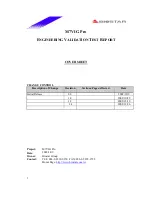
Chengdu Ebyte Electronic Technology Co.,Ltd.
E32-900MBL-01 User Manua
l
Copyright ©2012–2019
,
Chengdu Ebyte Electronic Technology Co.,Ltd.
8
2
Serial data transfer to
wireless transmission
After the serial port receives the data, it automatically starts to transmit the data
wirelessly. Of course, it contains some special command responses, which are mainly
used for special tests and can be ignored by the user. After the sending is completed,
the user function will be automatically called back to handle the sending logic by
itself.
3
Receive data wirelessly Generally, the internal status identifier of the module is read to determine whether
there is data, and the underlying driver will copy the data and pass it to the user
callback function, so as to process the receiving logic by itself
The software process is simplified as shown in the figure below:
2.4 Transceiving timing
The wireless module has multiple operating states, and can only perform specific functions in the corresponding
state. From the simplest way of sending and receiving data, only the sending mode and the receiving mode are
considered.
Item
Explanation
1
Receive mode
After the default initialization is completed, it will automatically enter the receiving
mode. In essence, the receiving function is called during initialization, and the
receiving mode is entered. If you need to consider entering other modes after
initialization, such as sleep, just replace it with the same type of function Go_xxxxx().
2
Send mode
When calling the sending function, the bottom driver actually switches the module into
the standby mode first, and usually completes the modulation parameter configuration
in this mode, such as frequency, power, frequency offset, etc. After the parameter
configuration is correct, gradually enter some intermediate modes, turn on the internal
FIFO, PA, external XTAL, etc., and the current consumption also gradually rises.
Finally, it switches to the sending mode and triggers wireless data transmission. After
completion, the module enters the standby mode. In this state, it cannot continue to
send and receive. The user needs to handle the next mode in the callback function.
When the function is complicated, continuous reception or continuous transmission is
required. Please switch to other modes according to the characteristics of the chip.


































